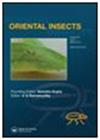西花蔷薇(蓟翅目:蓟科)对不同中国蔷薇品种颜色和挥发物的视觉和嗅觉偏好
IF 0.6
4区 农林科学
Q4 ENTOMOLOGY
引用次数: 1
摘要
摘要:在培养皿中,研究了西方富兰克林蝇对中国月季(红宝石、爱、游行、莫哈娜、粉红和平和光谱)的纸张颜色模拟物的自由选择,并在y管嗅觉仪上测试了它们对不同品种挥发物的行为反应。结果表明,西花菊对植物花挥发物的颜色偏好为黄色(Mohana≈Spectra) >红色(Ruby≈Love) >粉红色(Parade≈pink Peace),而对植物花挥发物的偏好为Ruby > Love > Parade > Mohana > pink Peace > Spectra。气相色谱-质谱分析表明,苯乙醇是红宝石、爱情和莫哈那挥发物中含量最高的单一成分,含量分别为37.3%、25.25%和33.13%。(Z)-3-己烯乙酸酯是Parade和Spectra挥发物中含量最高的成分,含量分别为39.87%和22.62%。香叶醇含量最高(16.07%);因此,当某些作物的不同品种大规模共同种植时,未来的缓解方法,如粘色诱捕器或/和引诱剂,仍可用于对特定品种的西花蓟马进行重点监测和控制。本文章由计算机程序翻译,如有差异,请以英文原文为准。
Visual and olfactory preferences of Frankliniella occidentalis (Thysanoptera: Thripidae) for color and volatiles of different Rosa chinensis (Rosales: Rosaceae) cultivars
ABSTRACT The free choice of Frankliniella occidentalis to the paper color simulative to Rosa chinensis cultivars (Ruby, Love,Parade,Mohana, Pink Peace, and Spectra) was tested in Petri dishes, and their behavioral responses to the volatiles of different these R. chinensis cultivars was tested in a Y-tube olfactometer. The results showed that F. occidentalis exhibited color preference for yellow (Mohana ≈ Spectra) > red (Ruby ≈ Love) > pink (Parade ≈ Pink Peace), whereas the preference for plant flower volatiles was Ruby > Love > Parade > Mohana > Pink Peace > Spectra. Gas chromatography mass spectrometry analysis showed that benzeneethanol was the single most abundant component in the volatile profiles of Ruby, Love, and Mohana, with contents of 37.03, 25.25, and 33.13%, respectively. (Z)-3-Hexenyl acetate was the most abundant component in the volatile profiles of Parade and Spectra, with contents of 39.87 and 22.62%, respectively. Geraniol (16.07%) was the most abundant component of the Pink Peace volatiles. Therefore, future mitigation approaches, e.g., color sticky traps or/and attractants, could be still used for the key monitoring and control of F. occidentalis on a particular cultivar when different varieties of certain crops were grown together on a large scale.
求助全文
通过发布文献求助,成功后即可免费获取论文全文。
去求助
来源期刊

Oriental Insects
生物-昆虫学
CiteScore
1.60
自引率
0.00%
发文量
34
审稿时长
>12 weeks
期刊介绍:
Oriental Insects is an international, peer-reviewed journal devoted to the publication of original research articles and reviews on the taxonomy, ecology, biodiversity and evolution of insects and other land arthropods of the Old World and Australia. Manuscripts referring to Africa, Australia and Oceania are highly welcomed. Research papers covering the study of behaviour, conservation, forensic and medical entomology, urban entomology and pest control are encouraged, provided that the research has relevance to Old World or Australian entomofauna. Precedence will be given to more general manuscripts (e.g. revisions of higher taxa, papers with combined methodologies or referring to larger geographic units). Descriptive manuscripts should refer to more than a single species and contain more general results or discussion (e.g. determination keys, biological or ecological data etc.). Laboratory works without zoogeographic or taxonomic reference to the scope of the journal will not be accepted.
 求助内容:
求助内容: 应助结果提醒方式:
应助结果提醒方式:


